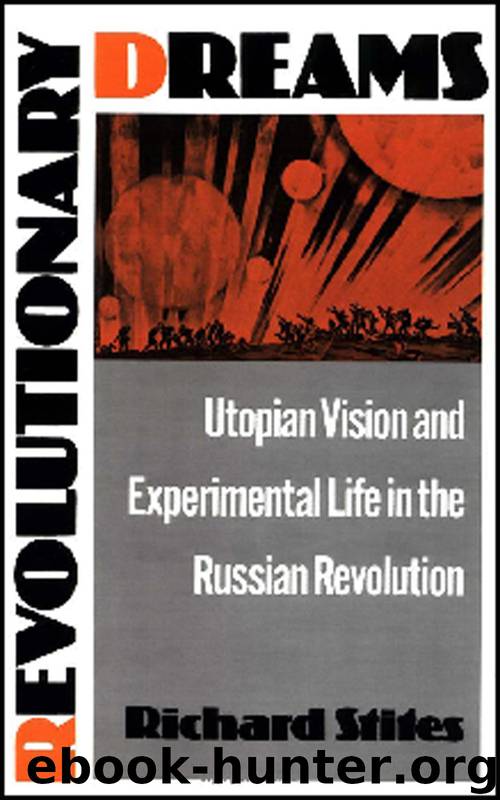Revolutionary Dreams by Stites Richard;

Author:Stites, Richard;
Language: eng
Format: epub
Publisher: Oxford University Press
Published: 1989-03-17T16:00:00+00:00
The Struggle for Time
Kerzhentsev’s contribution to the cult of man-the-machine shifted the emphasis from the body and the consciousness of the individual worker to society at large. Kerzhentsev yielded nothing to Gastev as a fanatic of efficiency in life, but his conception of life was broader. Like the popularizers of Taylorism in the United States who created a “normal American madness,” Kerzhentsev took Gastevism out of the factory and into the realm of everyday life.
Platon Mikhailovich Kerzhentsev (real name Lebedev) came from a loftier social and cultural background than Gastev’s, and he never tried to be a factory worker. His father, a physician, had been a liberal member of the First Duma. Kerzhentsev’s studies of peasant economy at Moscow University led him into Marxism and to the well-worn path of underground agitation, prison, and emigration in Europe. In 1904 he became a Bolshevik. After the failed 1905 revolution, Kerzhentsev blossomed into a minor journalist and traveled through Europe, America, and Japan. He acquired considerably more cosmopolitanism and culture than most of his colleagues in the N.O.T. movement. But this made him an extreme iconoclast during the Revolution and Civil War, when he gained notoriety as a theater critic who urged the complete overhaul of theatrical life. The iconoclastic impulse and the enthusiasm for the theatricalization of everyday life informed his brief excursion into the world of social management in the early 1920s. Both before and after this parenthetical episode, Kerzhentsev served in a number of minor diplomatic missions. The brevity of Kerzhentsev’s infatuation with Taylorism was characteristic of his tendency to jump from one cause to another.26
Kerzhentsev’s regular movement back and forth from the world of the theater—where precision always counts—to the bureaucratic world of early Bolshevism—where order and punctuality were very hard to enforce—led him into his angry war against inefficiency. In the midst of his writings on theater, he composed a short manual on How to Conduct a Meeting in 1919. He then joined the burgeoning N.O.T. movement and produced his first Taylorist work, The Principles of Organization. Kerzhentsev opposed Gastev’s excessive emphasis on worker training, but what made him cut out a new path was an episode that he described with great vividness. In July 1923, a meeting of some 3,500 workers was kept waiting for two hours before the speakers arrived to open it. An American journalist present (unidentified) calculated on the spot for Kerzhentsev that the 7,000 man hours lost could have been used to build one or two airplanes. Kerzhentsev was electrified by this revelation. Within a few weeks he had written an impassioned article in Pravda entitled “Time Builds Airplanes,” founded the League of Time, and produced his two major works on the subject, The Struggle for Time and The Scientific Organization of Labor.27
Like Gastev and other Taylorists, Kerzhentsev expostulated on the value of time—a commodity, he said, that foreigners instinctively revered due to their industrial environment, but that Russians ignore, misuse, and kill. Like Gastev, he also preached the gospel of personal time-keeping, thorough planning, alertness, and a “feeling for time.
Download
This site does not store any files on its server. We only index and link to content provided by other sites. Please contact the content providers to delete copyright contents if any and email us, we'll remove relevant links or contents immediately.
| Anarchism | Communism & Socialism |
| Conservatism & Liberalism | Democracy |
| Fascism | Libertarianism |
| Nationalism | Radicalism |
| Utopian |
The Secret History by Donna Tartt(16608)
The Social Justice Warrior Handbook by Lisa De Pasquale(11485)
Thirteen Reasons Why by Jay Asher(7782)
This Is How You Lose Her by Junot Diaz(5753)
Weapons of Math Destruction by Cathy O'Neil(5029)
Zero to One by Peter Thiel(4817)
The Myth of the Strong Leader by Archie Brown(4785)
Promise Me, Dad by Joe Biden(4440)
Stone's Rules by Roger Stone(4412)
Beartown by Fredrik Backman(4403)
How Democracies Die by Steven Levitsky & Daniel Ziblatt(4392)
The Fire Next Time by James Baldwin(4336)
100 Deadly Skills by Clint Emerson(4070)
A Higher Loyalty: Truth, Lies, and Leadership by James Comey(4024)
Rise and Kill First by Ronen Bergman(4008)
The David Icke Guide to the Global Conspiracy (and how to end it) by David Icke(3875)
The Farm by Tom Rob Smith(3869)
Secrecy World by Jake Bernstein(3773)
The Doomsday Machine by Daniel Ellsberg(3725)
